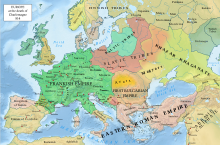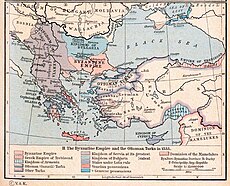Principality of Serbia (early medieval)
Principality of Serbia Кнежевина Србија Kneževina Srbija | |||||||||||||
|---|---|---|---|---|---|---|---|---|---|---|---|---|---|
| 780–960 | |||||||||||||
Emblem of
prince Strojimir | |||||||||||||
Vlastimir (notable) | |||||||||||||
• 850–891 | Mutimir (first Christian) | ||||||||||||
• 933–943/960 | Časlav (last) | ||||||||||||
| Historical era | Early Middle Ages | ||||||||||||
• Established | 780 | ||||||||||||
• Byzantine annexation | 960 | ||||||||||||
| ISO 3166 code | RS | ||||||||||||
| |||||||||||||
The Principality of Serbia (
An important process during this period was the
Background
Slavs (
Višeslav, Radoslav and Prosigoj (circa 780–830)

The time and circumstances of the first three Serbian rulers are almost unknown. The first of the dynasty known by name was
Although Višeslav is only mentioned by name, the DAI mentions that the Serbs served the Byzantine Emperor and that they were at this time at peace with the Bulgars, whose neighbors they were and with whom they shared a common frontier.
Višeslav was succeeded by his son
Countering Bulgarian expansion (805–829)
In the east, the
The Bulgarian Empire had a general policy of expansion in which they would first impose the payment of tribute on a neighboring people and the obligation of supplying military assistance in the form of an alliance (society), leaving them internal self-government and local rulers, and when the need for this kind of relationship expired, they would terminate the self-government of the said people and impose their direct and absolute power, integrating them fully into the Bulgarian political and cultural system.[38]
Vlastimir, Mutimir and Prvoslav (830–892)
Vlastimir succeeded his father, Prosigoj, in c. 830.
According to Constantine VII, the Serbs and Bulgars had lived peacefully as neighbours until the Bulgar invasion in 839 (in the last years of Theophilos).
After Vlastimir's death, the rule was divided among his three sons:
The Serbs and Bulgarians adopted the
Peter, Pavle and Zaharija (892–927)
The name Peter suggests that Christianity had started to permeate into Serbia, undoubtedly through Serbia's contacts with the Bulgarians and Byzantines. Peter secured himself on the throne (after fending off a challenge from Klonimir, son of Stojmir) and was recognized by
Although allied to
Symeon attacked Serbia (in 917) and deposed Peter, placing
Časlav (933–943/960)

The Bulgarian rule over Serbia lasted only three years. After Symeon died,
During this apogee of Serbian power, Christianity and culture penetrated Serbia, as the Serb prince lived in peaceful and cordial relations with the Byzantines. However, strong as it had grown to be, Serbia's power (as in other early Slavic states) was only as strong as its ruler. There was no centralized rule, but instead a confederacy of Slavic principalities. The existence of the unified Grand Principality was dependent on the allegiance of the lesser princes to Časlav. When he died defending Bosnia against
After this, there is a gap in the history of hinterland Serbia (in later western sources: Rascia),[59] as it was annexed by the Byzantine Empire (c. 970). The dynasty continued to rule the maritime regions, and in the 990s, Jovan Vladimir rose as the most powerful Serbian prince, ruling over present-day Montenegro, eastern Herzegovina, and northern Albania. This state became known as Duklja, after the ancient Roman town of Doclea. However, by 997, it was made subject to tsar Samuel of Bulgaria.[58]
When the Byzantines finally defeated the Bulgarians, they regained control over most of the Balkans for the first time in four centuries. Serbian lands were governed by a strategos presiding over the Theme of Sirmium. However, local Serbian princes continued to reign as vassals to the Byzantine Emperor, maintaining local autonomy over their lands, while only nominally being Byzantine subjects. Forts were maintained in
Fall and aftermath
After Časlav died c. 943/960, the hinterland of Serbia was annexed by the Byzantines and reorganized as the
Government
| Vlastimirović dynasty |
|---|
The Serbian ruler was titled "Prince (
Historian B. Radojković (1958) proposed that Serbia was a "divided principality". According to him, Višeslav could have been a chief military leader (veliki vojvoda) who with his company seized the entire power in his hands and turned himself into a hereditary ruler, as Veliki župan; in this way, the first Serbian state was thus established after 150 years of permanent living in the new homeland and existence of
Geography
Cities
According to DAI, baptized Serbia included the following cities (καστρα/kastra),[66][67][68] with spellings used in Moravcsik's transcript (1967):
| "Inhabited city" | Notes |
|---|---|
| Serbia (proper) | |
| Destinikon (Δεστινίκον) | Slavicized as Destinik and Dostinik. —Unidentified[69] |
| Tzernabouskeï (Τζερναβουσκέη) | Slavicized as Crnobuški and Černavusk. —Unidentified[69] |
| Megyretous (Μεγυρέτους) | Slavicized as Međurečje (meaning "[land] between rivers"). —Unidentified[69] |
| Dresneïk (Δρεσνεήκ) | Slavicized as Drežnik and Drsnik. —Unidentified[69] |
| Lesnik (Λεσνήκ) | Slavicized as Lešnik and Lesnica —Unidentified[69] |
| Salines (Σαληνές) | Slavicized as Soli. —Tuzla[69] |
| Bosnia | |
| Katera (Κατερα) | Slavicized as Kotor.[70] —Unidentified[69][71] |
| Desnik (Δέσνηκ) | —Unidentified.[17][71][69] |
Religion
By the beginning of the 7th century, Byzantine provincial and ecclesiastical order in the region was destroyed by invading Sclaveni and Pannonian Avars. The church life was renewed in the same century in the province of Illyricum and Dalmatia after a more pronounced Christianization of the Serbs and other Slavs by the Roman Church.[72][1][73] [74] In the 7th and mid-8th century the area wasn't under jurisdiction of the Patriarchate of Constantinople.[75] Early medieval Serbs are accounted as Christian by 870s,[76] but it was a process that ended in the late 9th century during the time of Basil I,[77] and medieval necropolises until the 13th century in the territory of modern Serbia show an "incomplete process of Christianization" as local Christianity depended on the social structure (urban and rural).[78] Basil I probably sent at least one embassy to Mutimir of Serbia,[79] who decided to maintain the communion of Church in Serbia with the Patriarchate of Constantinople when Pope John VIII invited him to get back to the jurisdiction of the bishopric of Sirmium (see also Archbishopric of Moravia) in a letter dated to May 873.[80][81][82] It is considered that Destinikon was an ecclesiastical centre and capital of early medieval Serbia.[83][1][84]

The seal of
The imperial charter of Basil II from 1020 to the Archbishopric of Ohrid, in which the rights and jurisdictions were established, mentions that the Episcopy of Ras belonged to the Bulgarian autocephal church during the time of Peter I (927–969) and Samuel of Bulgaria (977–1014).[89][90] It is considered that it was possibly founded by the Bulgarian emperor,[83][91] or it is the latest date when could have been integrated to the Bulgarian Church.[92] If previously existed, it probably was part of the Bulgarian metropolis of Morava, but certainly not of Durrës.[93] If it was on the Serbian territory, seems that the Church in Serbia or part of the territory of Serbia became linked and influenced by the Bulgarian Church between 870 and 924.[94][95][96] Anyway, the church would have been protected by Bulgarian controlled forts.[97] By then, at the latest, Serbia must have received the Cyrillic alphabet and Slavic religious text, already familiar but perhaps not yet preferred to Greek.[98]
Notable early church buildings include the
Archaeology
| History of Serbia | |
|---|---|
 | |
| 1071–1217 | |
| Kingdom of Serbia | 1217–1346 |
| King Dragutin's realm | 1282–1325 |
| 1346–1371 | |
| Lordship of Prilep | 1371–1395 |
| Prince Lazar's Serbia | 1371–1402 |
| Vuk's Land | 1371–1412 |
| Despotate of Serbia | 1402–1537 |

